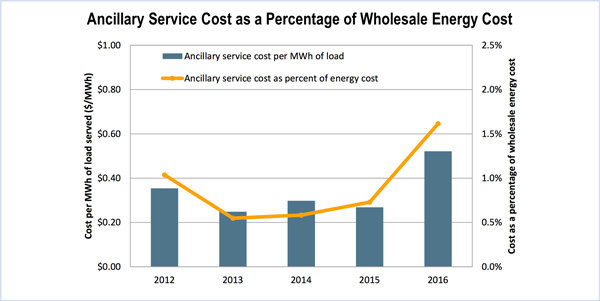By Robert Mullin
CAISO’s wholesale costs to serve load last year fell by 9% to $7.4 billion, the lowest nominal expense since 2008, according to an annual market performance report from the ISO’s internal Monitor.
The Department of Market Monitoring also used the report to signal its growing support for lifting FERC-imposed bidding restrictions on some participants in the Western Energy Imbalance Market (EIM).
The Monitor attributed much of the drop in wholesale costs to a 9% decline in prices for natural gas, with increased output form solar and hydroelectric resources and decreased transmission congestion also contributing. Electricity prices averaged $34/MWh over the year, down $3 from 2015.
The report noted the impact of CAISO’s growing number of low-cost solar resources, which accounted for about 83% of the 2,300 MW of new summer peak generating capacity installed in the ISO during 2016, along with 300 MW of newly built gas-fired peaking generation and 50 MW of additional energy storage.
“Solar energy is expected to continue to increase at a high rate during the next few years as a result of projects under construction to meet California’s renewable portfolio standards,” the Monitor said in its report. “This continues to increase the need for flexible and fast ramping capacity that can be dispatched by the ISO to integrate increased amounts of variable energy efficiently and reliably.”
Renewable integration efforts during the first half of 2016 drove sharp increases in ancillary services costs, which nearly doubled to $119 million, accounting for 1.6% of total wholesale energy costs, compared with 0.7% in 2015.
During the second quarter, ancillary services costs averaged 81 cents/MWh, more than 50% above the yearly average. The increase in large part stemmed from the ISO’s expanded seasonal procurement to manage a growing surplus of solar and hydro during California’s spring run-off. (See CAISO: Forecasting Challenges Drove Increased Regulation Requirements.)
The Monitor estimates about 1.6% of solar generation was dispatched down in the real-time market last year, with the largest reductions — about 3.4% — occurring during March as a result of low seasonal loads coinciding with relatively high solar output.
“More solar generation was economically dispatched down in 2016 compared to 2015 primarily because there was more inexpensive hydroelectric generation available throughout the year,” the Monitor said.
Just 0.3% of forecasted wind output was dispatched lower in real time throughout the year, which the Monitor attributed to the tendency of wind resources to bid into the market at relatively lower prices than solar.
Non-economic curtailments of renewable resources declined last year, the Monitor noted, likely because of the expansion of the EIM, the West’s only real-time energy market. The EIM’s inclusion of NV Energy in late 2015 and Arizona Public Service last fall significantly increased imbalance transfer capacity out of California, increasingly turning the state into an exporter of renewable generation to other areas of the West. (See EIM Report Show Continued Growth in CAISO Exports.)
The Monitor said improved transfer capability helped ensure competitiveness in the EIM, with mitigation of bids triggered by congestion occurring in the market’s participating balancing areas during only 1 to 4% of intervals.
“This increased structural competitiveness provides a basis for DMM to support removing special bidding restrictions currently placed by FERC on some Energy Imbalance Market participants,” the Monitor said, referring to Berkshire Hathaway Energy affiliates PacifiCorp and NV Energy.
FERC last year rejected a request by the two companies to rehear a 2015 decision prohibiting them from bidding generation into the EIM at market-based rates. The commission determined that both companies must provide market power analysis for EIM sub-markets as well as the market as a whole, a condition that would apply to any EIM member (See Berkshire Denied Rehearing on Market Power.)
The Monitor said that analysis it performed last year indicates that the inclusion of NV Energy’s transfer capacity “dramatically” reduced PacifiCorp’s potential to exercise market power in the EIM by significantly improving the links between the ISO and PacifiCorp’s balancing area.
“This structural competitiveness mitigates the potential for the exercise of market power through both economic and physical withholding during most intervals,” the Monitor said.
CAISO has “partially” addressed some of the Monitor’s own recommendations for improving competitiveness in the EIM, the Monitor noted, including increased enforcement of measures meant to account for internal transmission constraints and improved modeling of PacifiCorp transmission limits to better reflect the congestion impact of contracted line capacity.
The Monitor said it would support eliminating the bidding restrictions once all the concerns in FERC’s orders have been addressed.





